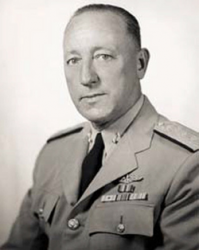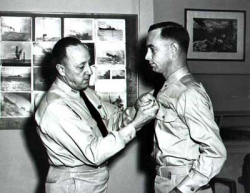
 |
|
|
||
|
Charles Andrews Lockwood, Jr. |
||||
|
Graduate, U.S. Naval Academy, Class of 1912 Engagements: • World War II (1941 - 1945) |
||||
| Biography: | ||||
|
Charles Andrews Lockwood, Jr. Charles Andrews Lockwood, Jr. was born on 6 May 1890 in Midland, VA. Lockwood graduated from the U.S. Naval Academy in the class of 1912. Following brief cruises aboard the battleships USS Mississippi (BB-23) and USS Arkansas (BB-33), and a short tour as Instructor in the Naval Training Station, Great Lakes, IL, in September 1914 he reported to the tender USS Mohican for indoctrination in submarines. Submarine Commander By 1 December 1914, he had his first submarine command, USS A-2, followed by USS B-1. America's entry into World War I found him Commander of Submarine Division 1, Asiatic Fleet. From that time, with the exception of a tour on the Asiatic station where he commanded gunboats USS Quiros (PG-40) and USS Elcano (PG-38) on the Yangtze Patrol and the destroyer USS Smith Thompson (DD-212), practically all his sea service was in, and/or connected with, submarines. In addition to those listed above are added USS G-1, USS N-5, USS UC-97 (ex-imperial German navy), USS R-25, USS S-14, and USS Bonita (SS-165). World War II Service In June 1939, he became Chief of Staff to Commander Submarine Force, U.S. Fleet, on the cruiser USS Richmond (CL-9). This important service was interrupted in February 1941 when he was sent to London as Naval Attaché and Principal Observer for Submarines. Following promotion to Rear Admiral in May 1942, he arrived in West Australia as Commander, Submarines, Southwest Pacific (COMSUBSOWESPAC). He also acted as Commander, Allied Naval Forces, based in Western Australia until July 1942. In February 1943, following the death of the COMSUBPAC, Rear Admiral Robert Henry English, in a plane crash in California, Lockwood was transferred to Pearl Harbor to become Commander, Submarines, Pacific Fleet (COMSUBPAC), in which capacity he served the rest of the war, being promoted to Vice Admiral in October 1943. Lockwood's strong leadership and devotion to his sailors won him the nickname "Uncle Charlie." Submarine patrols were long voyages and many times the crew finishing up on "iron rations" of poor food as their food supplies ran out, so Lockwood made great strides in providing for rest and recuperation (R & R) for his sailors when they returned to port, such as two week stays at the Royal Hawaiian Hotel, and crates of ice-cream and leafy vegetables to greet returning submarine crews. Lockwood oversaw the introduction into the Pacific Fleet of a huge number of newly-constructed fleet submarines from American shipyards, including the one in Manitowoc, WI, and the manning of them with newly-trained officers and men. Older boats, like the S-class, were removed from combat and sent back to the U.S. for use in training or to be scrapped. He oversaw the moving forward of the Pacific Fleet submarine bases from Pearl Harbor, HI, and Australia to places like Saipan - where a submarine tender was stationed for a period of time - Guam, the Admiralty Islands, and Subic Bay, the Philippines. This reduced the very long ocean voyages for American submarines, and steadily tightened the noose on Imperial Japanese supply lines, especially in the East China Sea and the South China Sea. He pushed the Navy's Bureau of Ships and Bureau of Ordnance to provide his men with the most effective submarines and torpedoes possible. He oversaw the tests that proved the unreliability of U.S. torpedoes, which at the time were often running too deep or failing to detonate, and prompted the improvements that made them the highly-effective weapons they became in 1944 and 1945. In fighting for better torpedoes, Lockwood had to fight the Mark 14 torpedo and Mark VI exploder supporter Admiral Ralph Waldo Christie. Most importantly, Lockwood cleaned out the "dead wood," replacing timid and unproductive submarine skippers with (often) younger and more aggressive officers. During the early stages of the Pacific War, U.S. skippers were relatively complacent and docile, compared to their German counterparts who understood the "life and death" urgency in the Atlantic. There was plenty of room for error and cautious judgment since the Japanese did not take the U.S. submarine threat seriously. In 1942 and early 1943, U.S. submarines proved little threat to Japanese warships and merchant ships alike. As a result of Lockwood's initiatives, the "silent service" suddenly began racking up many kills, including key enemy warships. Most importantly, U.S. submarines were responsible for severing Japan's shipping routes to their colonies in Southeast Asia, by sinking close to half of their merchant ships. The Imperial Japanese Navy was caught off guard and never recovered. After the war, Lockwood served as the Naval Inspector General until his retirement in June 1947. In Retirement In retirement at Los Gatos, CA, he authored and contributed to several best-selling books on naval history and submarine operations, including Tragedy at Honda, Sink-Em All, Through Hell and Deep Water, Hell at 50 Fathoms, Zoomies, Subs and Zeros, Hellcats of the Sea, Battles of the Philippine Sea, and Down to The Sea in Subs: My Life in the U.S. Navy. In one of his book promotion speeches following the war, Lockwood mentioned that he was an avid deer hunter. After the speech, he was approached by Ralph T. Duncan, a pharmacist living in Los Gatos, CA. Duncan invited Lockwood to be his guest that year at Jake's Opening Hunting Club, near Boonville, CA. They became fast friends. After Lockwood had been deer and quail hunting at the club for several years as Duncan's guest, Lockwood learned of an amazing coincidence: that it was on the same hunting club property that Admiral English (Lockwood's predecessor as submarine fleet commander) had died in the crash of the Philippine Clipper flying boat. It was because of the death of English that Lockwood had been given command of the Pacific submarine fleet. Medals and Awards Navy Distinguished Service Medal (3 Awards) Honors The frigate USS Lockwood (FF-1064) was named in his honor. Death and Burial Vice Admiral Charles Andrews Lockwood, Jr. died on 6 June 1967. He is buried at Golden Gate National Cemetery in San Bruno, CA, alongside his wife and Admirals Chester Nimitz, Raymond Spruance, and Richmond Kelly Turner, an arrangement made by all of them while living. |
||||
| Honoree ID: 2776 | Created by: MHOH | |||
Ribbons
Medals
Badges
Honoree Photos
 |  |  |
 |  |
 |


